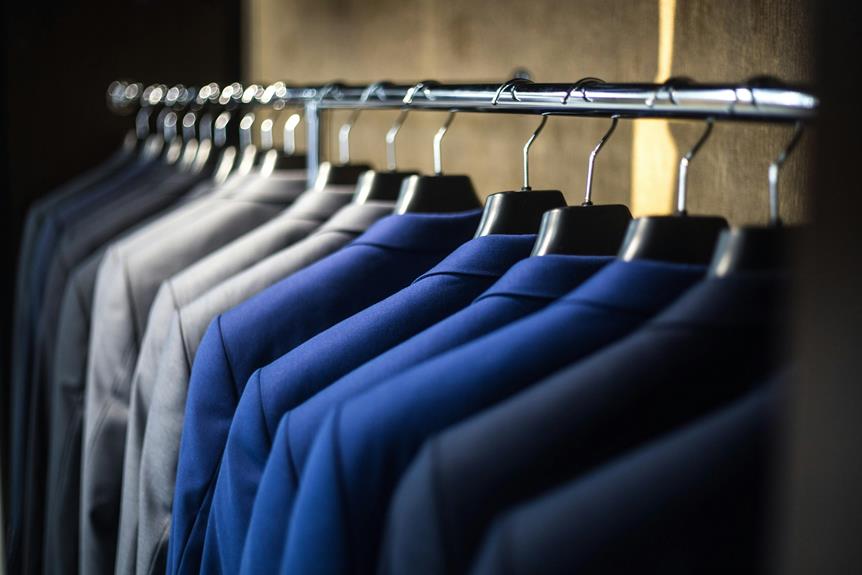When you want your fabrics to feel soft and smell fresh, knowing how to use fabric softener effectively is key. You'll need to consider the type of softener that best suits your laundry needs and the right timing for adding it during the wash cycle. It's also crucial to stick to dosage guidelines to avoid any unintended residue. But what about those common mistakes that could undermine your efforts? Understanding these nuances can make a significant difference, so let's explore how to achieve the best results for your fabrics.
Table of Contents
Key Takeaways
- Add fabric softener during the rinse cycle to effectively coat fibers and enhance softness.
- Use the recommended dosage based on load size to prevent residue buildup on fabrics.
- Choose the right type of fabric softener, such as liquid, dryer sheets, or hypoallergenic options, based on your needs.
- Avoid overloading the washing machine to ensure even distribution of the softener.
Understanding Fabric Softeners
Have you ever wondered how fabric softeners actually work to make your laundry feel softer and smell fresher? These products contain a mix of chemicals that interact with the fibers in your fabrics. When you add fabric softener during the rinse cycle, it coats the fibers with a thin layer of lubrication. This reduces friction between the fibers, making your clothes feel smoother and more comfortable against your skin.
Additionally, fabric softeners often include fragrance compounds that cling to the fabric, leaving behind a pleasant scent. This is why your laundry smells so fresh after using them. The softener helps to reduce static cling as well, which can be a nuisance, especially in synthetic fabrics. By neutralizing static electricity, your clothes won't stick together or cling to your body.
It's also important to note that using fabric softeners can enhance the durability of your fabrics. By softening the fibers, you're reducing wear and tear during washing and drying.
However, be cautious not to overuse them, as excess buildup can lead to greasy residues on your clothes. Understanding how fabric softeners work helps you achieve the best results for your laundry.
Types of Fabric Softeners
When picking a fabric softener, you've got a couple of main options to consider: liquid fabric softeners and dryer sheets.
Each type has its own benefits and uses, making it easy to find the right fit for your laundry routine.
Let's take a closer look at both choices and see how they can enhance your laundry experience.
Liquid Fabric Softeners
Liquid fabric softeners are popular for their ability to reduce static cling and leave your laundry feeling soft and fresh. They work by coating the fibers of your clothes, making them smoother and more manageable. When you use a liquid fabric softener, you'll notice the difference in both texture and scent.
Here are some key benefits of using liquid fabric softeners:
- Static Reduction: They help minimize static electricity, making your clothes easier to wear and handle.
- Fragrance: Many liquid softeners come in delightful scents, adding a fresh aroma to your laundry.
- Ease of Use: You can simply add them to your washing machine during the rinse cycle for convenient application.
To get the best results, be sure to follow the instructions on the bottle regarding the amount to use. Experiment with different scents and brands until you find the one that suits your preferences.
With liquid fabric softeners, you'll enjoy softer, fresher laundry every time.
Dryer Sheets Options
Dryer sheets offer a convenient alternative to liquid fabric softeners, providing softness and static control in a simple, easy-to-use format. You can toss one or two sheets into the dryer with your laundry, and they'll do the work for you. There are various types of dryer sheets available, each designed to meet different needs and preferences.
Here's a quick comparison to help you choose:
| Type | Features |
|---|---|
| Standard Sheets | Basic softness and static reduction |
| Scented Sheets | Infused with fragrance for fresh smell |
| Hypoallergenic Sheets | Designed for sensitive skin |
| Eco-friendly Sheets | Made from biodegradable materials |
| Dryer Balls | Reusable option that softens fabrics |
When selecting dryer sheets, consider your laundry habits and any sensitivities you or your family may have. Standard sheets will work just fine for everyday use, while scented ones can give your fabrics that extra freshness. If you're looking for sustainability, eco-friendly sheets or dryer balls might be the way to go. Ultimately, choose what fits your needs best!
How to Use Fabric Softener
To get the best results from fabric softener, add it to your washing machine during the rinse cycle. This ensures that the softening agents effectively coat your fabrics, leaving them feeling soft and smelling fresh. Here's how to do it right:
- Choose the right fabric softener: Select a product that suits your needs, whether you prefer liquid, dryer sheets, or pods.
- Check your washer's dispenser: Many machines have a designated compartment for fabric softener. If yours does, pour the recommended amount in before starting the rinse cycle.
- Avoid mixing with detergent: Don't combine fabric softener with detergent in the same compartment, as it can reduce effectiveness and lead to residue buildup on your clothes.
Following these steps will help you achieve the soft, fresh fabrics you desire.
Dosage Guidelines
Finding the right dosage of fabric softener is crucial for achieving optimal softness and freshness in your laundry. Using too little mightn't deliver the results you want, while using too much can leave residue on your fabrics and even affect absorbency.
Start by checking the label on your fabric softener bottle. Most products provide specific dosage guidelines based on your load size. For standard loads, a common recommendation is about a quarter to a third of a cup. If you're washing larger loads or heavier fabrics like towels or blankets, you may want to increase the amount slightly, but avoid going overboard.
When using a washing machine, add the fabric softener during the rinse cycle for best results. If your machine has a designated fabric softener dispenser, fill it according to the manufacturer's instructions.
For those using a dryer, just a small amount on a dryer sheet can suffice.
Tips for Best Results
To get the best results from your fabric softener, you need to consider a few key points.
First, choosing the right type of softener for your laundry is crucial.
Then, using proper dilution techniques and timing your application can make all the difference in achieving that soft, fresh feel.
Choose the Right Type
Choosing the right fabric softener can significantly enhance your laundry's freshness and softness. When you pick the right type, you not only improve the feel of your fabrics but also extend their lifespan. Here are some tips to help you choose the best fabric softener for your needs:
- Liquid vs. Dryer Sheets: Liquid fabric softeners are great for washing machines, while dryer sheets are convenient for dryer use. Decide based on your laundry routine.
- Scent Preferences: Think about the fragrances you enjoy. Some softeners offer light scents, while others provide stronger aromas. Choose one that complements your style.
- Sensitive Skin Options: If you or your family has sensitive skin, opt for hypoallergenic or fragrance-free softeners to avoid irritation.
Proper Dilution Techniques
Properly diluting fabric softener ensures you get the most out of its benefits while preventing any residue buildup on your clothes. To achieve the best results, follow these simple dilution techniques. First, always read the label on your fabric softener for specific instructions. Most fabric softeners should be diluted before use, especially concentrated ones.
Here's a quick reference table to help you with dilution ratios:
| Fabric Softener Type | Water Ratio | Application Method |
|---|---|---|
| Concentrated | 1:3 | Mix in a spray bottle |
| Standard | 1:2 | Add to washing machine |
| Eco-friendly | 1:4 | Use in rinse cycle |
When mixing, use lukewarm water to ensure the fabric softener dissolves properly. After dilution, apply the mixture directly to your laundry in the wash cycle or in a fabric softener dispenser. This method helps distribute the softener evenly. Remember, less is more; using too much can lead to a sticky residue on fabrics. Happy laundering!
Optimal Usage Timing
Using fabric softener at the right moment during your laundry cycle can significantly enhance its effectiveness and your fabric's softness. To achieve the best results, you need to know when to add the softener. Typically, you should add it during the rinse cycle, as this allows the softener to coat the fibers without being washed away by detergent.
Here are some tips to optimize your fabric softener usage:
- Read the Label: Always check the fabric softener instructions for specific recommendations on timing and dosage.
- Use the Right Cycle: If you're using a washing machine with multiple cycles, opt for the rinse cycle that matches the load size.
- Don't Overdo It: Using too much softener can lead to buildup on fabrics, making them feel greasy rather than soft.
Common Mistakes to Avoid
One of the biggest mistakes people make is overloading the washing machine, which can prevent fabric softener from distributing evenly. When you cram too many clothes in, the fabric softener won't coat your fabrics properly, leading to stiff and rough results.
Another common error is adding fabric softener too early in the wash cycle. It's designed to be rinsed out, so make sure to add it during the rinse cycle for the best results. You should also avoid using too much softener; more isn't always better. Excessive amounts can lead to residue buildup, making your clothes feel greasy.
Lastly, don't ignore the care labels on your clothing. Some fabrics, like microfiber or moisture-wicking materials, can be damaged by fabric softeners. Always check before you use it.
Here's a quick reference table to help you avoid these mistakes:
| Common Mistakes | Solutions |
|---|---|
| Overloading the washer | Wash in smaller loads |
| Adding too early | Add during the rinse cycle |
| Using too much | Follow the recommended amount |
| Ignoring care labels | Always check fabric labels |
| Not cleaning the dispenser | Clean it regularly |
Frequently Asked Questions
Can Fabric Softener Help Reduce Static Cling?
Yes, fabric softener can help reduce static cling. It coats the fibers in your laundry, making them smoother and less likely to stick together. Just add it during the rinse cycle for the best results.
Is Fabric Softener Safe for Baby Clothes?
Yes, fabric softener can be safe for baby clothes if you choose a gentle, hypoallergenic formula. It helps keep fabrics soft and fresh, but always check for any potential allergies or sensitivities before using it.
Does Fabric Softener Affect Towel Absorbency?
Yes, fabric softener can affect towel absorbency. It creates a coating on fibers, reducing their ability to soak up water. If you want maximum absorbency, consider skipping the softener when washing your towels.
Can I Use Fabric Softener on Athletic Wear?
You shouldn't use fabric softener on athletic wear. It can leave a residue that reduces moisture-wicking properties, making your gear less effective. Stick to detergent to keep your performance apparel in top shape.
How Does Fabric Softener Impact the Environment?
Fabric softener can negatively impact the environment by introducing chemicals that harm aquatic life and ecosystems. You can reduce this effect by choosing eco-friendly options or skipping softeners altogether for a more sustainable laundry routine.
- How Does Ring Spun Cotton Affect Garment Fit and Shape Retention? - August 13, 2024
- What Are the Challenges in Producing Ring Spun Cotton? - August 13, 2024
- Is Ring Spun Cotton Suitable for Plus-Size Clothing? - August 13, 2024





